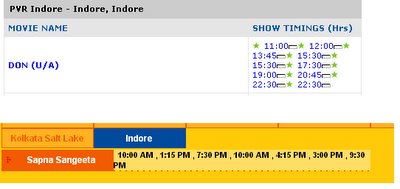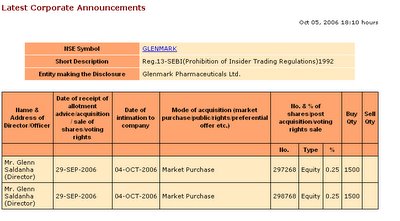I am currently in Indore and it was really difficult to watch a movie as they were hardly any good theatres to talk of. Well enter the consumer age and things have rapidly changed over the past year. Three big multiplexes has reached this place. FAME Adlabs, PVR Cinemas and Inox. With an average of 4-6 screens, these corporate theater companies can house close to 1200 people at any given point in time.
Given the nature of this business, where people do not want to watch movies in theatres twice or thrice as it was earlier, most of these theatres need to reach to the audience really fast. Enter the idea of more than the standard number of shows per day with odd hour shows. Even if this were not enough, multiple screens are being used to show the same movie. Something that was close to a taboo in earlier days.
A good friend of mine was looking at the availability of tickets for DON, a new movie of Shah Rukh Khan in Indore. The results that came out was astonishing. I have attached two clippets on the same below from two of the four important theaters in Indore that follow a similar business model. The number of shows/day that was shown by these theatres in the next few days exceed 30! At an average 250 seats/screen, this translates to 7500 a day and for a week this will be 90000. At a 85% utilization rate and a cost of Rs. 125/ ticket, Indore citizens are going to spend a crore on movie watching this week for DON ! Phew that is a lot for a movie. What are the plans for the second and third week or the next month? Who is there to watch this movie in such a big theater? If I were to add the cost of the eatables, parking for this movie, another Rs. 100-125 is going to go off most of them. Movies are getting expensive!

Movies has taken a new turn today. It is no more the number of days that makes a difference to the director. No more do you see movies harping on running for 100 days, 200 days etc. It is how much money do you make during the first week, how much did you lose over the previous week, marginal loss in ticket sales!
It is important that we look at new-age theatres in a new light because the business model for most of these companies has changed.
- Most of them are looking at first week sales quite closely. Quite evident from the number of shows shown.
- Movies are getting extremely short-lived. The theater companies can be blamed for this. In their primary interest of capturing most of the movie-goers to their screens, they are showing more shows leading to lesser number of days for a movie. For people like me who like watching after the initial euphoria dies down, I end up missing most of them as they are never there on screens at a later date.
- New initiatives like SMS Booking and Internet booking makes sense to most of us. While I do not know the risks faced by these companies, I see this model making some change as there is no need to stand in a line, the ticket is confirmed and no anxiety is associated with getting tickets.
- Companies are also looking at the food counter closely. I know Satyam in Chennai did outsource this section thus making it profitable for them. Today, we tend to take something during the first section of the movie too rather than having something during and after intermission.
- Pricing has changed for the tickets. They are getting extremely expensive. The reason primarily arises from the huge infrastructure and maintenance costs for these theatres.
- With most of them running empty during the week and the non-availability of good movies at all times, good movies is getting expensive and so does huge variation in movies during the weekends and weekdays.
- It is nice to see the business model changing, it is even better to see an active corporatisation in theater distribution. Corporatisation is making distribution system. Earlier we had theater owners with less than 3-4 screens. Now companies like Inox, PVR Cinemas and Adlabs are consolidating the screens around the country. Directors can start actively looking at negotiating with the screen owners rather than the old model of having the middlemen. The old system can't die this early with the penetration still low in the Tier 2-Tier 3 cities but there is a step towards this direction. Also, this increases the bargaining power for these companies for better revenue sharing.
- Business revenues has changed drastically. What was earlier a function of days with a standard set of shows for a movie has now changed to more than 5 shows a day/screen to multiple screens for the same movie. This makes modelling more difficult as a bad movie can just see audience vanish creating huge unutilized seat for a screen and this will lead to huge unrecoverable variable costs.
- Also, weekdays and weekend pricing will start seeing some changes. With unutilizated capacity, price cutting will get into the place between theatres making it even more difficult. As most of these companies are still expanding, revenues from existing theaters has still not stabilized.
- This business is getting a bit murkier for an investor because there is hardly much to distinguish between the theatres. I am yet to see loyalty to any of these theaters by the audience.
- Business revenues are coming not only from ticket sales but also from the food counter. On a average every customer spends on a coke and a popcorn for two people. This is a revenue of close to Rs. 50 and a margin of around 60%. This is a strong stream and one that should not be overlooked.
